Choose The Materials For The Island.
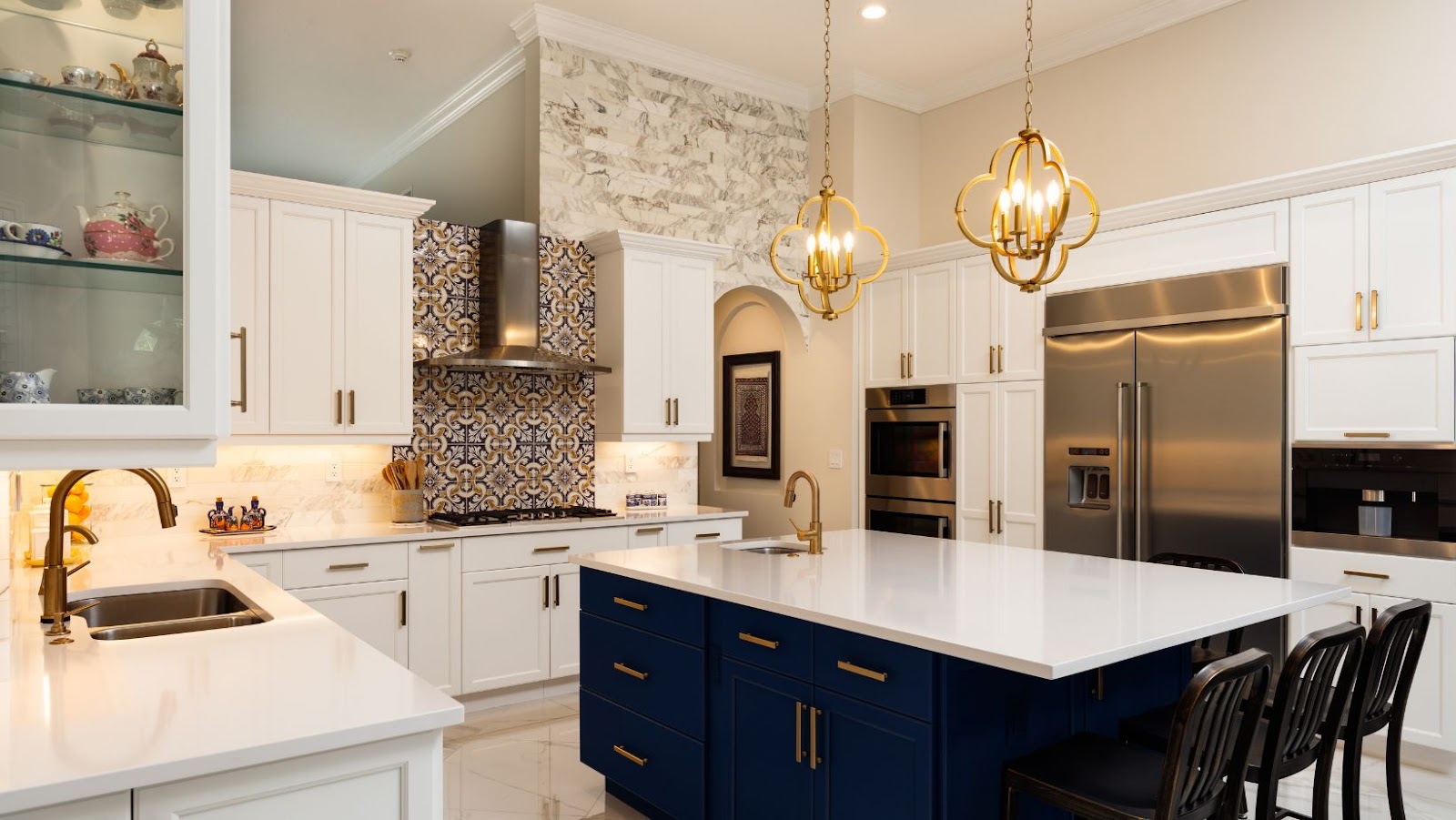
Choosing the right materials for your kitchen island is key in designing a functional and visually appealing space.
How to Design a Kitchen Island
1. Butcher block: This material provides a warm and natural look that’s perfect for a rustic or farmhouse-style kitchen. It’s also durable and resistant to stains.
2. Marble/Granite: These materials lend a sleek and modern look to your kitchen island and are perfect for baking or working with dough as they provide a cool surface.
3. Concrete: Concrete can be moulded into any shape, making it perfect for custom kitchen islands. It’s also heat-resistant, durable and easy to maintain.
4. Stainless Steel: This material offers a clean, industrial look that’s perfect for modern kitchens. It’s durable, easy to clean, and resists stains and bacteria growth.
5. Wood: Wood offers a timeless look that’s perfect for traditional and contemporary kitchens alike. It’s durable, heat-resistant, and can be finished in a variety of stains to match your kitchen decor.
Make sure to consider your budget, style preference and most importantly your functional requirements while choosing the materials for your island.
Types of Island Materials
When deciding how to design a kitchen island, one of the most important decisions to make is which material to use for the island. There are a variety of materials that can be used to construct a kitchen island and each has its own unique set of benefits. Let’s have a look at the different types of materials that can be used to create a kitchen island and the benefits of each.
Wood
Wood is a popular material choice for designing a kitchen island due to its durability, versatility, and aesthetic appeal. Here are the different types of wood used for designing a kitchen island:
1. Maple: Maple wood is known for its durability, affordability, and light colour. It is a popular choice for modern kitchens as it can be stained to match the colour of the cabinets.
2. Oak: Oak wood is a classic choice for kitchen islands, known for its strength, water-resistant properties, and unique grain pattern. It offers a traditional look and can be easily stained or painted to match the kitchen décor.
3. Cherry: Cherry wood is a high-end choice for kitchen islands, known for its unique reddish-brown colour, smooth grain, and durability. It is a bit more expensive than other wood types.
4. Birch: Birch wood is a sustainable and eco-friendly choice, known for its light colour, even grain, and affordability. It can be finished with different stains or paints to create a custom look.
5. Walnut: Walnut wood is a premium choice for kitchen islands, known for its unique dark brown colour, rich grain pattern, and durability. It is ideal for a timeless and sophisticated look.
Pro tip- When choosing wood for your kitchen island, consider the wear and tear it will face, ease of maintenance, and how well it complements the cabinetry and overall kitchen design.
Granite
Granite is a popular material for kitchen island countertops due to its durability, strength, and timeless beauty. However, there are different types of island materials to consider when designing your kitchen island.
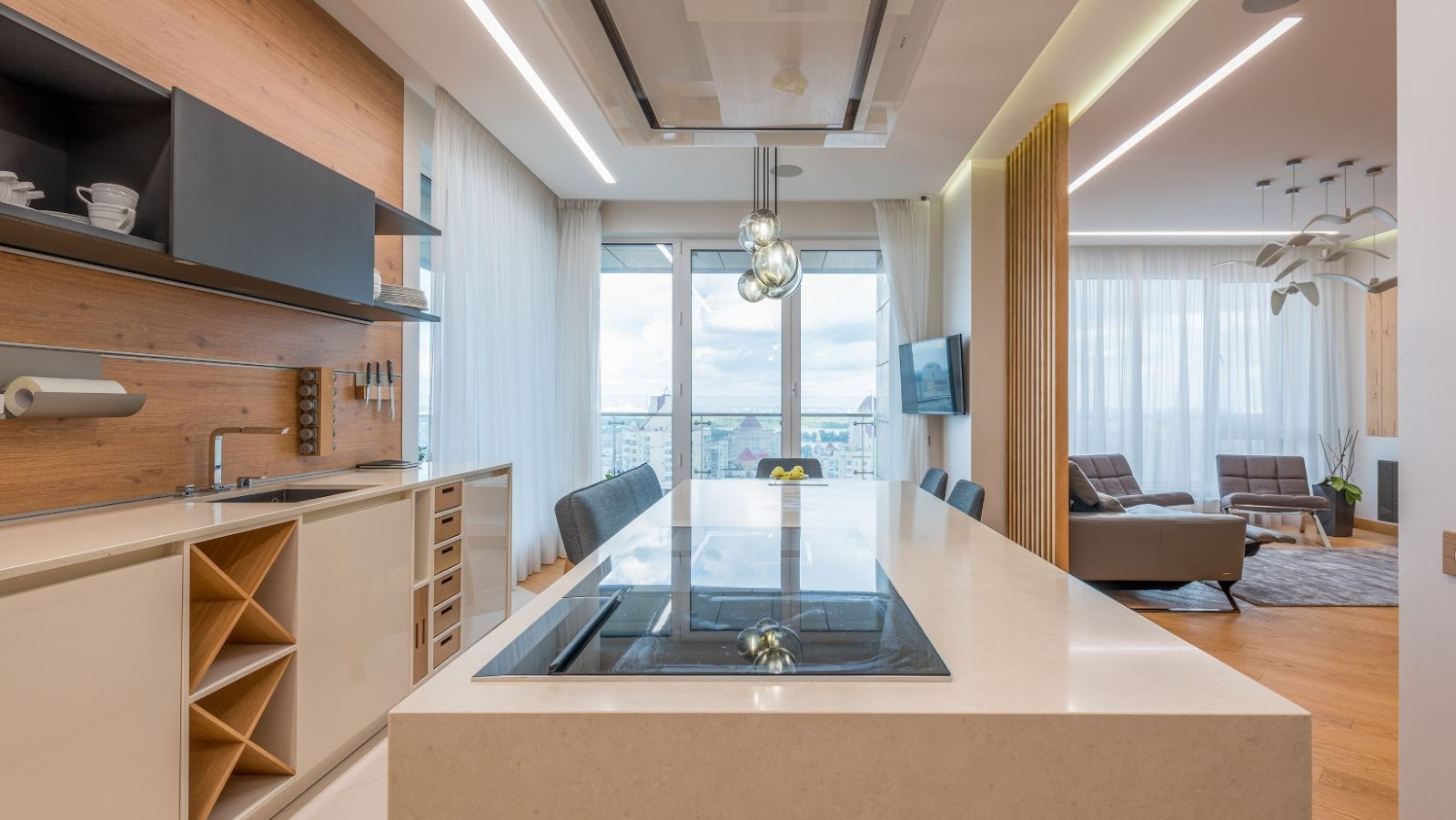
Quartz: Quartz is a non-porous, scratch-resistant, and low-maintenance material suitable for high-traffic areas such as the kitchen island.
Marble: Marble is a luxurious and elegant material that comes in a wide range of colors and patterns, perfect for creating a unique kitchen island. However, it requires regular sealing and maintenance to prevent scratches and stains.
Wood: Wood adds warmth and texture to the kitchen, creating a cozy and inviting space. Butcher block and reclaimed wood are popular choices for kitchen islands.
Stainless Steel: Stainless steel is sleek, durable, and easy to clean, making it the perfect material for professional-grade kitchen islands or contemporary-style kitchens.
Concrete: Concrete is a durable and versatile material that allows for customization in shape, size, and finish. It has a modern, industrial look that fits well with minimalist or contemporary kitchen designs.
Marble
Marble is a popular material choice for kitchen islands, providing a sleek and elegant look to any kitchen. However, it is important to consider the types of island materials available before choosing marble for your kitchen island.
Here are a few types of island materials to consider:
Wood: A classic and versatile material, wood adds warmth and texture to any kitchen island design. It is durable and can be easily customised to fit your unique style and needs.
Stainless steel: This material offers a modern and sleek look, is durable, and easy to clean.
Concrete: Concrete offers a contemporary and industrial look, is durable, and can be customised with stains, pigments, and textures.
Quartz: A popular choice for its durability and low-maintenance, quartz is available in a wide variety of colours and patterns that can mimic the look of natural stone like marble.
Ultimately, the best material for your kitchen island depends on your style, needs, and budget. Consider the overall aesthetic of your kitchen and the functionality of your island before choosing the material.
Quartz
Quartz is a popular material option for designing a kitchen island due to its durability, low maintenance, and aesthetic appeal. Here are a few factors to consider in choosing quartz for your kitchen island:
1. Colour and style: Quartz countertops come in a wide range of colours and patterns to fit various kitchen design themes.
2. Size and shape: Quartz can be cut and shaped to fit any kitchen island design, making it a versatile choice for various kitchen layouts.
3. Durability: Quartz is scratch-resistant, heat-resistant, and can withstand heavy use, making it an ideal material for high traffic areas in the kitchen.
4. Maintenance: Quartz is non-porous, which means it’s easy to clean and won’t harbour bacteria or stains.
By considering these factors, you can choose the right quartz material for your kitchen island that will serve you well for years to come.
Concrete
When designing a kitchen island, the choice of material is crucial to ensure its durability, functionality, and aesthetic appeal. Concrete is an excellent material for an island because of its versatility and durability. There are different types of concrete to choose from, including cast-in-place, precast, and glass fibre reinforced.
Cast-in-place: This type of concrete is poured on the site of the island’s installation, allowing for customization and adaptability to the surroundings.
Precast: Precast concrete slabs are premade and then transported to the site for installation, offering consistency in quality and uniformity in design.
Glass fibre reinforced: This type of concrete has added glass fibres that reinforce its durability and strength, ideal for high-use kitchen islands.
Concrete allows for customization in shape and size, making it perfect for uniquely shaped and sized kitchen islands. Additionally, it offers a contemporary look and is easy to clean and maintain.
Pro-tip: When designing a concrete kitchen island, ensure that it is properly sealed and finished to increase durability and resistance to stains and scratches.
Factors to Consider When Choosing Materials
When it comes to designing a kitchen island, it is essential to choose the right materials for the island in order to create a functional, stylish, and durable design.
There are a number of factors to consider when choosing materials for a kitchen island, including material cost, maintenance, and durability.
Let’s take a closer look at the factors to consider when choosing materials for a kitchen island.
Durability & Maintenance
When designing a kitchen island, the durability and maintenance of materials must be taken into account to ensure a long-lasting and functional addition to your home.
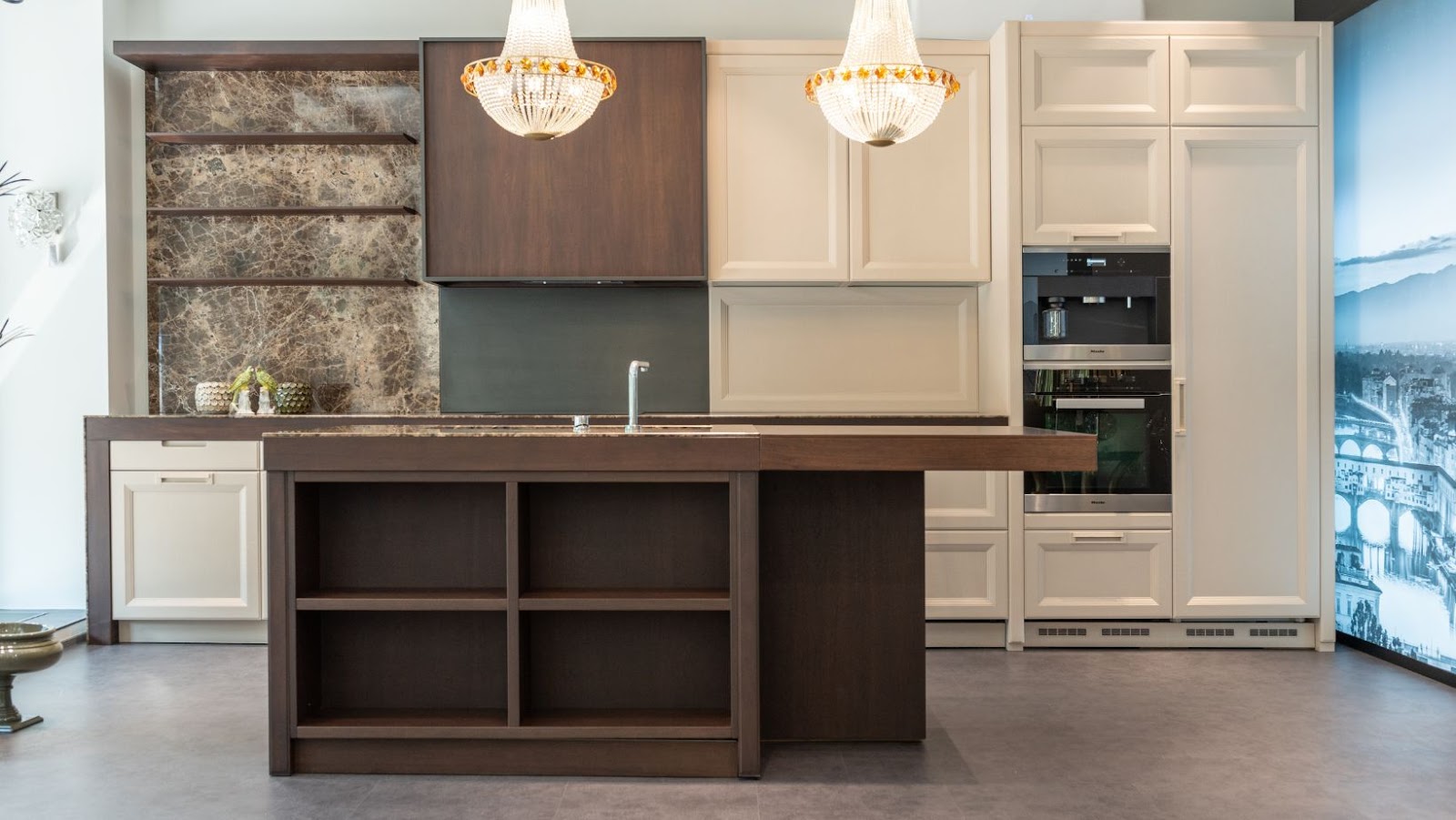
Here are some factors to consider when choosing materials for your kitchen island:
Durability: The materials you choose should be able to withstand daily wear and tear, heat and moisture fluctuations and resist scratches, and stains. Granite, quartz, and solid surface countertops are long-lasting and heat-resistant options.
Maintenance: Choose materials that are easy to clean and maintain. Avoid porous materials such as marble and wood as they can absorb spills and require extra care. Instead, opt for materials such as laminate or stainless steel that are easy to clean and require less maintenance.
Style: The materials you choose should complement your overall kitchen design and colour palette. Pick colours and textures that blend in with the kitchen’s theme but have an elegance of their own.
By keeping these factors in mind, you’ll be able to choose durable, low-maintenance materials that are both stylish and functional for your kitchen island.
Pro tip: Prioritise versatility over fashion. A kitchen island should be designed for functionality first and aesthetic second.
Cost
When designing a kitchen island, one of the most important considerations is the cost of materials. Choosing the right materials can both save you money and help you achieve your design goals. Here are some factors to consider:
Budget: Determine your overall budget first and choose materials accordingly. For example, granite or marble countertops may not fit within a tight budget, while laminate or butcher block could be more cost-effective.
Durability: Look for materials that will stand up to daily use like Quartz or Quartzite, which is more affordable than Granite or Marble.
Style: Consider the overall aesthetic of your kitchen and choose materials that complement your design choices. For example, a stainless steel island may look great in a modern kitchen, while a wooden island might fit better in a traditional one.
Maintenance: Make sure you consider the long-term maintenance requirements of your chosen materials, such as sealing or polishing for natural stones.
By considering these factors, you can choose materials that strike the perfect balance between aesthetics, functionality, and budget for your kitchen island.
Style And Design
When designing a kitchen island, choosing the right materials is crucial to both the aesthetic and functional aspects of the island.
Here are some factors to consider when selecting materials:
Durability: Kitchen islands are high-traffic areas that are prone to scratches, spills, and moisture. Choosing durable materials like granite, concrete, or natural stone can ensure that your island lasts a long time.
Style: The style of your kitchen island should complement the overall design of your kitchen. Consolidating natural materials like wood and stone with sleek design elements like stainless steel or polished concrete countertops can create an on-trend look.
Function: Consider how you will use your kitchen island before choosing materials. For example, if you plan to use the island for food preparation, a heat-resistant surface like quartz or granite could be a more practical choice.
Budget: Different materials have different costs. Choose materials that fit your budget while still fulfilling your functional and aesthetic needs for the kitchen island.
By considering all of these factors, you can select the best materials for your kitchen island, creating a beautiful and functional centrepiece for your kitchen.
Pros And Cons of Each Material
When it comes to designing a kitchen island, there are a variety of materials to choose from. Each material has its own pros and cons that you should consider when making your selection.
This article will discuss the pros and cons of each material, from wood to stone, to help you choose the best one for your kitchen island.
Wood Pros And Cons
Wood is a popular material choice for designing a kitchen island because it offers a variety of benefits and drawbacks to consider before making a final decision.
Pros of using wood for a kitchen island:
- Aesthetics: Wood provides natural warmth and character to a kitchen, adding a rustic or contemporary feel depending on the style.
- Durable: Certain types of wood, such as oak, maple, and cherry, are long-lasting and resistant to wear and tear.
- Variety: Wood is available in a wide range of styles, grains, and colours, making it a versatile option for any kitchen design.
Cons of using wood for a kitchen island:
- Maintenance: Wood requires regular maintenance to keep it looking its best, including oiling or staining to prevent scratches and water damage.
- Cost: High-quality woods can be expensive, which may make it challenging for those on a tight renovation budget.
- Susceptible to damage: Wood is susceptible to scratches, dings, and water damage, so it may not be the best option for those with young children or a busy kitchen.
When choosing the material for your kitchen island, consider the pros and cons of each material, such as wood, to ensure that it aligns with your design goals and practical needs. Pro Tip: Opt for high-quality wood and perform regular maintenance to ensure a long lifespan for your kitchen island.
Granite Pros And Cons
Granite is one of the most popular materials for kitchen islands, but like any material, it has its pros and cons that you need to consider before making a decision.
Pros:
- Durability – Granite is a hard and durable material that can withstand heat and scratches.
- Aesthetics – Granite comes in many colors and patterns, making it easy to match with a kitchen’s design.
- Resale value – Investing in a granite kitchen island can increase the overall value of your home.
Cons:
- Cost – compared to other materials, granite can be quite expensive.
- Maintenance – While durable, granite requires regular cleaning and sealing to prevent damage and staining.
- Weight – Granite is a heavy material, which can affect the installation process and require additional support.
When choosing a material for your kitchen island, consider the overall style of your kitchen, maintenance requirements, and cost. If you decide to go with granite, make sure you have a professional installation and follow the recommended maintenance routine.
Pro Tip: Mix and match materials for your kitchen island for a unique and functional look. For example, use granite for the top and base, and wood or metal for the legs or storage shelves.
Marble Pros And Cons
Marble is an elegant and timeless material that is often used for designing kitchen islands. However, there are several pros and cons that you should consider before choosing marble for your kitchen island, as well as other materials.
Pros of using Marble:
- Marble adds a touch of luxury, elegance, and value to your kitchen.
- It has a heat-resistant surface that is ideal for rolling and kneading dough.
- It comes in a variety of colours and patterns, allowing you to choose the look that suits your style.
Cons of using Marble:
- Marble is porous, which means it stains easily and requires regular sealing and cleaning.
- It is a soft stone that can be scratched, chipped or dented.
- Marble is expensive and requires professional installation.
Other Materials:
- Granite: Durable and scratch-resistant, but more expensive than marble.
- Quartz: Can mimic the look of marble without requiring as much maintenance.
- Butcher Block: Ideal for cutting and chopping, but susceptible to water damage.
Make sure to weigh the pros and cons of each material before choosing the one that’s right for your kitchen island.
Quartz Pros And Cons
Quartz is a popular material choice for kitchen islands due to its durability, non-porous surface, and low maintenance. However, it does have some pros and cons that should be considered before choosing it as your island material.
Pros:
- Scratch-resistant: Quartz is one of the most scratch-resistant materials used for countertops, making it ideal for a high-traffic area like a kitchen island.
- Easy to clean: The non-porous surface of quartz makes it resistant to stains and bacteria growth, making it easy to clean and maintain.
- Wide variety of colours and patterns: Quartz comes in a wide range of colours and patterns, making it easy to match the overall design of your kitchen.
Cons:
- Expensive: Quartz is one of the more expensive materials used for kitchen islands.
- Heat sensitive: Quartz is not heat resistant and can discolour or crack when exposed to high temperatures.
- Not completely natural: While quartz is made primarily from natural materials, it is still an engineered stone and not completely natural in origin.
Keep these pros and cons in mind when choosing the material for your kitchen island to ensure that it fits your budget, style, and maintenance needs.
Concrete Pros And Cons
Concrete has become a popular material for designing kitchen islands due to its unique texture and durability. However, like any other material, there are pros and cons to using concrete.
Pros:
- Durability – Concrete is a long-lasting material that can withstand the wear and tear of daily use.
- Design versatility – Concrete can be moulded and coloured to match any kitchen design or style.
- Heat-resistant – Concrete is heat-resistant, making it an ideal surface for cooking and food preparation.
Cons:
- Price – Concrete can be an expensive material to work with, especially if customised.
- Heavy – Due to its weight, working with concrete can be challenging and requires proper installation.
- Porous – Concrete is porous and requires sealing to prevent stains, which can be time-consuming.
When considering concrete as a material for your kitchen island, weigh the pros and cons to make an informed decision that suits your design style and budget.

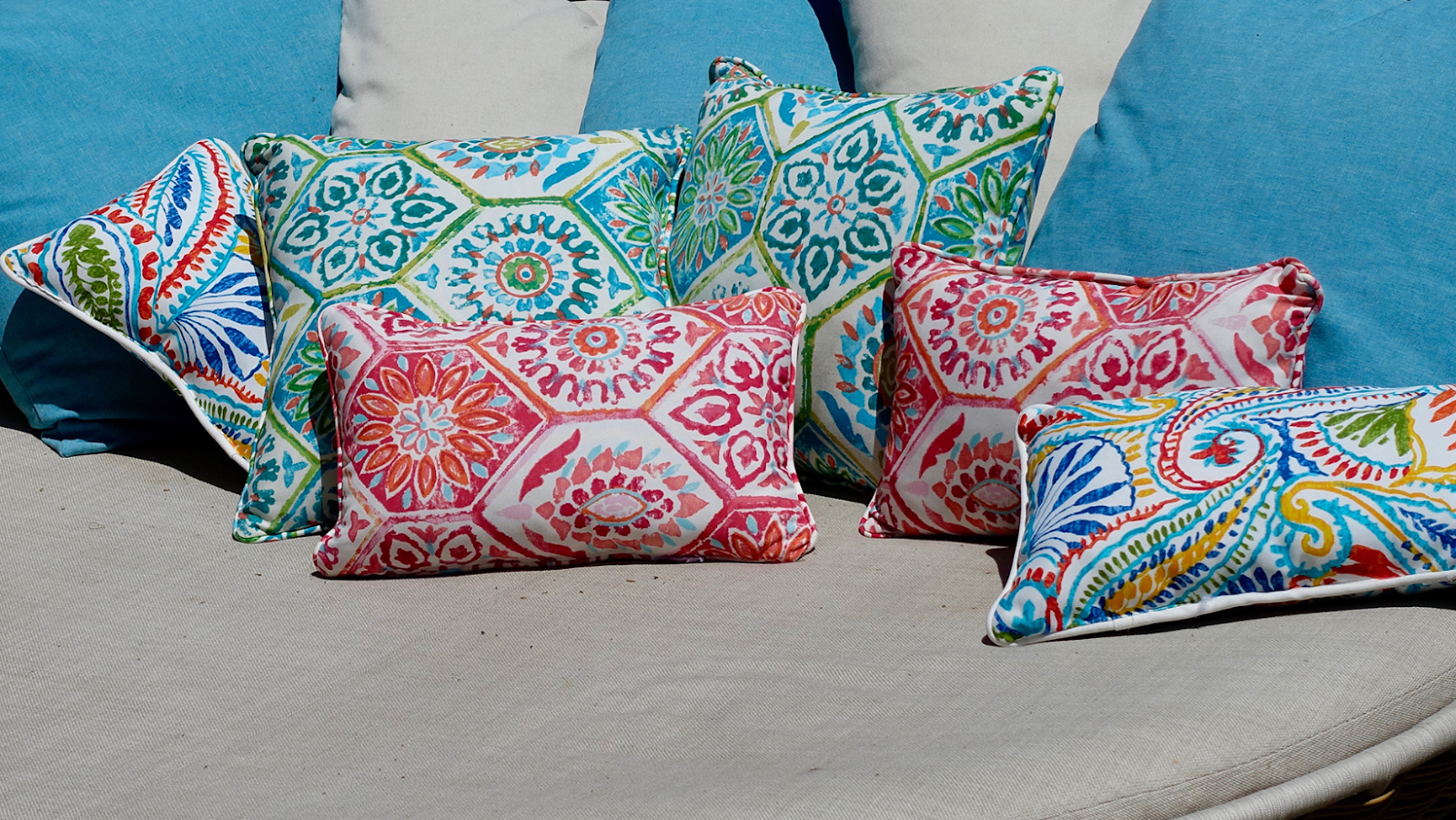 The Benefits Of Outdoor Sofa Deep Seating
The Benefits Of Outdoor Sofa Deep Seating 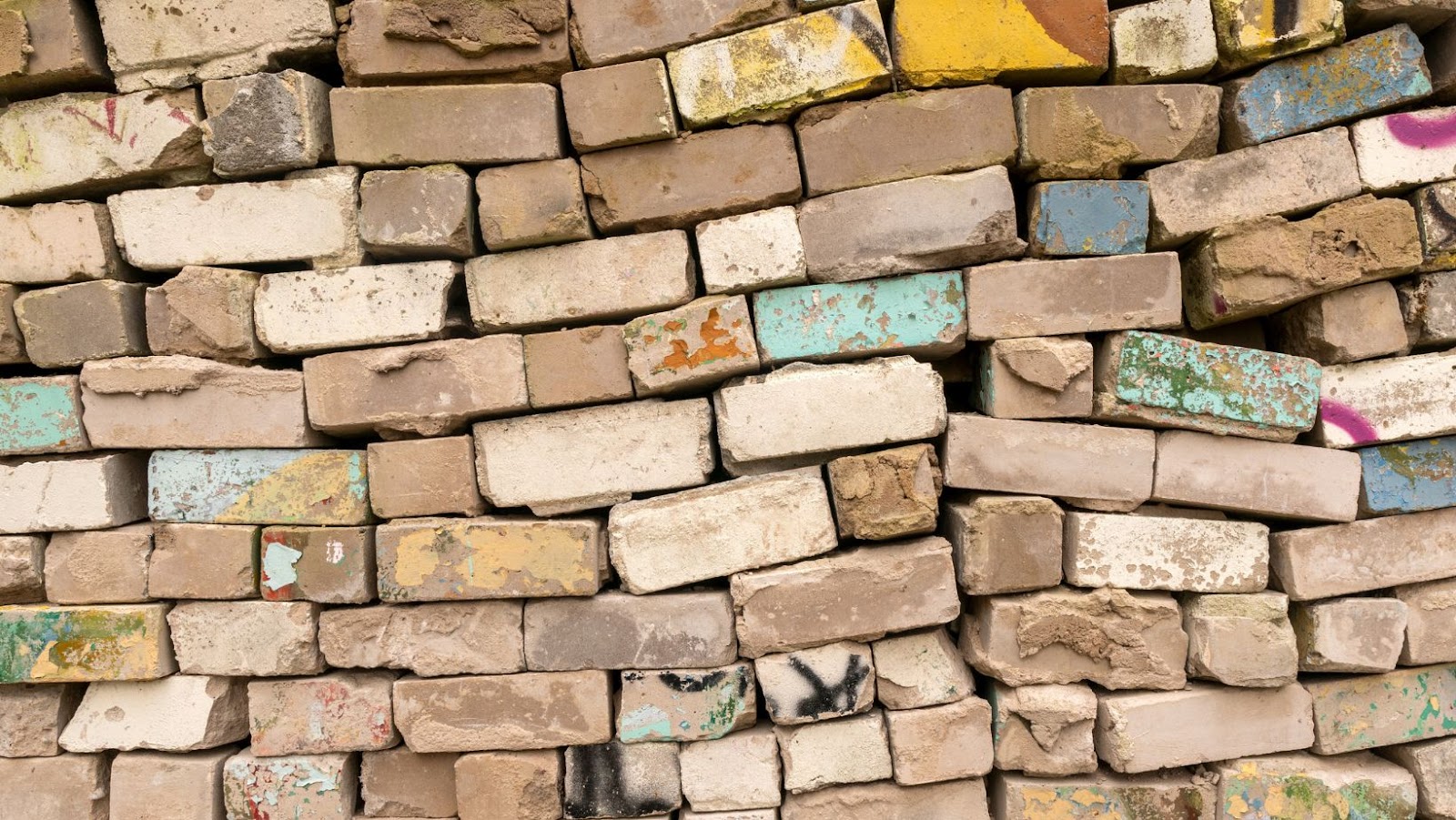 This Method has Been Used for Centuries
This Method has Been Used for Centuries  The Different Types of Bonds
The Different Types of Bonds  Solar Panel Cost And Efficiency
Solar Panel Cost And Efficiency  The Most Comfortable Deep Seating Outdoor Furniture
The Most Comfortable Deep Seating Outdoor Furniture  Maintaining Your Glass Cabinet Doors
Maintaining Your Glass Cabinet Doors